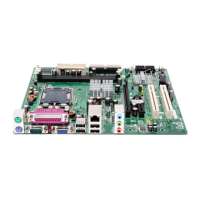Intel
®
Desktop Board D102GGC2 Specification Update
2. The following note will be added to the Technical
Product Specification in Section 2.7.1 Back Panel
Connectors:
INTEGRATOR’S NOTES
Electrostatic discharge (ESD) can damage desktop board
components. Front-panel connectors should provide sufficient
protection to prevent ESD damage to components inside the
chassis enclosure.
3. Reference to support for second-generation SATA drives
is being removed. Section 3.3.2 PCI IDE Support will
change its entirety as follows:
3.3.2 PCI IDE Support
If you select Auto in the BIOS Setup program, the BIOS automatically sets
up the PCI IDE connector with independent I/O channel support. The IDE
interface supports hard drives up to ATA-66/100 and recognizes any ATAPI
compliant devices, including CD-ROM drives, tape drives, and Ultra DMA
drives. The interface also supports SATA drives. The BIOS determines the
capabilities of each drive and configures them to optimize capacity and
performance. To take advantage of the high capacities typically available
today, hard drives are automatically configured for Logical Block Addressing
(LBA) and to PIO Mode 3 or 4, depending on the capability of the drive. You
can override the auto-configuration options by specifying manual
configuration in the BIOS Setup program.
To use ATA-66/100 features the following items are required:
• An ATA-66/100 peripheral device
• An ATA-66/100 compatible cable
• ATA-66/100 operating system device drivers
NOTE
Do not connect an ATA device as a slave on the same IDE cable
as an ATAPI master device. For example, do not connect an ATA
hard drive as a slave to an ATAPI CD-ROM drive.

